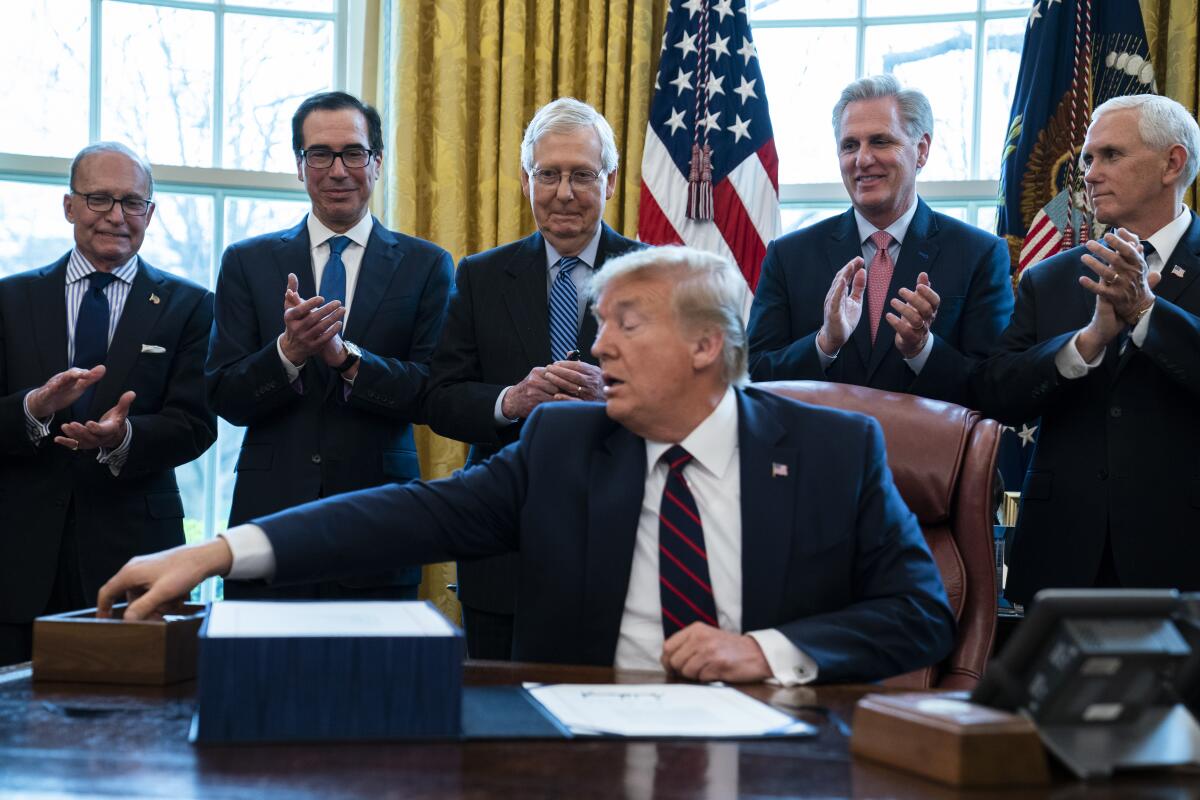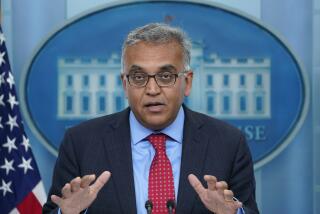Despite widespread shortages, Trump hasn’t come up with a plan to get medical supplies where needed

WASHINGTON — Even as President Trump ordered General Motors Friday to begin manufacturing ventilators, the president’s broader strategy to get desperately needed medical supplies to hospitals and doctors across the country remained shrouded in uncertainty.
Administration officials have refused to provide answers to questions from lawmakers, governors and healthcare leaders who have been pleading for federal assistance with masks, ventilators and other equipment.
And the U.S. Department of Health and Human Services hasn’t outlined a plan for procuring and distributing medical supplies, despite an 8-year-old executive order that directed the agency to detail how it would identify and prioritize equipment and medications needed in a national emergency.
“We need ... supplies for healthcare workers and for communities,” said Rep. Katie Porter (D-Irvine), who has been pressing the administration for details about its supply plan. “Unfortunately, the administration doesn’t appear to have done the work.”
On Friday, Trump invoked the Defense Production Act, a Korean War-era law, to order General Motors to begin manufacturing ventilators at one of its auto plants after he had attacked the company on Twitter for not moving more quickly.
The president also announced that he was tapping White House trade advisor Peter Navarro, a former economics professor without manufacturing or supply-chain experience, to oversee implementation of the decades-old law.
“We’re prepared to do vast numbers,” Trump said at the White House, promising a rapid manufacture and distribution of medical supplies. “We’re in great shape.”
The White House, however, hasn’t detailed any broader strategy for addressing shortages of a host of other supplies, including respirator masks, gowns, face shields and other protective equipment.
Nick Vyas, executive director of the Marshall Center for Global Supply Chain Management at USC, said that the administration should have stepped into the market last month to begin directing supplies. “The time to act was four weeks ago,” he said.
A similar lack of preparation slowed the development and distribution of coronavirus testing kits in January and February, which continues to hinder the nation’s response to the widening pandemic.
Much of the debate around use of the Defense Production Act has focused on its potential to force companies like GM to make supplies deemed essential during a national emergency. Trump has repeatedly said he is confident U.S. manufacturers will voluntarily ramp up production of medical equipment, an argument echoed by the U.S. Chamber of Commerce.
But the law also gives federal agencies the authority to place orders for critical materials and can give selected orders a higher priority than orders from private-sector companies or state and local governments.
The U.S. Department of Homeland Security has used this authority in past emergencies, including following Hurricane Katrina in 2005. For example, the agency helped a major railroad company get switches to rebuild railroad lines damaged by the storm by prioritizing the switch order and allowing the company to get the switches from its supplier in 10 days instead of having to wait 90.
Many experts believe the Trump administration could similarly speed the delivery of scarce medical supplies to hospitals and medical providers that face the biggest shortages.
Instead, states and medical systems are increasingly competing against one another in a chaotic marketplace where everyone is scrambling to get the same supplies.
Neither the Department of Health and Human Services nor the Federal Emergency Management Agency would answer questions from The Times about federal planning to address the crisis.
Efforts to come up with a more effective system go back years. In 2012, President Obama issued an executive order directing the Department of Health and Human Services and other agencies to develop systems for prioritizing supplies in an emergency and establishing standards for ordering and distributing the supplies.
But the federal health agency did not complete the regulations to develop this system, according to a June 2019 report to Congress by FEMA. Nor has the agency posted any regulations related to the act since then.
The lack of such a system doesn’t prevent the federal government from using its authority to help get critical supplies.
But a better developed system would help substantially, said Vyas at USC. “With a robust command-and-control system in place, it would be much easier and much more efficient to fight the battle the right way and with the right resources,” Vyas said.
Instead, there has been widespread confusion as the shortages become more acute nationwide and the Trump administration continues to send mixed messages about what it will do.
Governors from both parties have become increasingly critical of the federal government’s disorganization, which Massachusetts Gov. Charlie Baker, a Republican, called out Thursday.
“I have had confirmed orders for millions of pieces of gear evaporate in front of us, and I can’t tell you how frustrating it is,” Baker said, blaming the Trump administration for out-bidding his state for medical equipment.
On Tuesday, FEMA Administrator Peter Gaynor announced he was using the Defense Production Act to procure about 60,000 coronavirus test kits. Later that day, Trump appeared to reject this. And Tuesday evening, a FEMA spokeswoman said the agency was able to obtain the kits without employing the law.
It still unclear how FEMA developed the test kit order, as the agency is refusing to answer questions.
More to Read
Get the L.A. Times Politics newsletter
Deeply reported insights into legislation, politics and policy from Sacramento, Washington and beyond. In your inbox three times per week.
You may occasionally receive promotional content from the Los Angeles Times.












